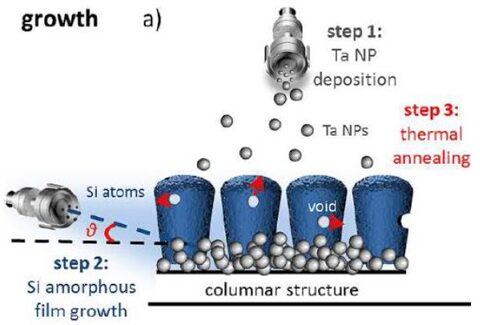Silicon Anodes having a Nano-Vault Structure


The video shows that as silicon atoms are deposited in the presence of nanoparticles, columns grow in the shape of an inverted cone.
Problem
Si-based materials are a promising alternative to graphite anodes for high-energy lithium ion batteries (LIBs) because of their tenfold increase in theoretical capacity. However, the huge Si volume change during lithiation and delithiation causes electrode fracture and hinders the formation of stable solid electrolyte interfaces (SEIs), reducing the Coulombic efficiency.
Solution
To overcome the above problem, a vaulted structure with a resultant arch action is introduced at the nanoscale. This arch structure demonstrates possibilities for new designs in Si anodes for LIBs but is also eligible for other materials and applications where surface mechanics play a critical role (e.g. hydrogen storage, bio-implants, etc.). The fabrication of the vaulted structure is a result of a three-step growth method (Fig. a), leading to columnar amorphous Si films. Arch action is observed exactly when columns contact each other, sealing the anode in a vault-like structure which favors dissipation of stress, preventing Si electrodes from cracking during lithiation/delithiation cycling. Most importantly, the vaulted structure can be piled up repeatedly, thus increasing the amount the Si and both electrode and SEI stability simultaneously.
Applications
-Lithium Ion Batteries
Benefits
-Durability
-Increased Cyclability
-High Energy Capacity
-High Coulombic Efficiency
Keywords
Silicon Anode Battery
Opportunity
-Available for licensing
Patent Status
-Patented
Files
Contact Details
Business Development Section/Technology Licensing Section
bdtl@oist.jp or +81-(0)98-966-8937/ +81-(0)98-966-8993
Browse other licensing opportunities



